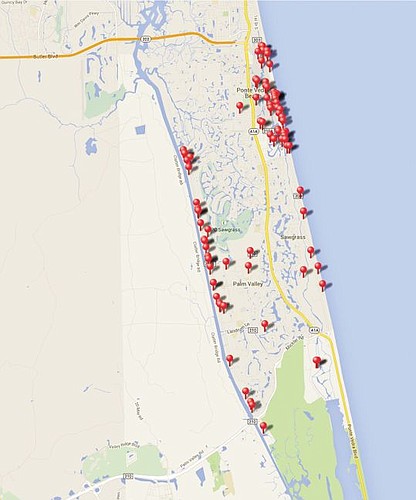
The lots for the neighboring beach houses are the same size — one-third of an acre — and the dirt beneath each, worth $2.15 million.
Beyond that, the two Ponte Vedra Beach homes have little in common.
On the left is a one-and-a-half story 1935 bungalow.
On the right, a two-story 2007 McMansion nearly three times the size. It replaced a house demolished two years prior.
Total home values: $2.3 million for the bungalow, $4.5 million for the teardown and re-build.
Teardowns in Ponte Vedra Beach were popular in the early 2000s. Now they’re back.
Demolition permits, which once numbered 30 per year and dipped to 10 yearly during the recession, have bounced back to 20 and 25 annually for the last four years.
And, the practice is spreading, bleeding into south Jacksonville Beach and popping up in some of Atlantic Beach’s oldest neighborhoods.
It’s not a profit-driven phenomenon, but simply a practical solution. Old beach homes today have little value compared to the lots upon which they sit.
“It’s the high-end luxury market — on the beach — where this is happening,” said Pam Henry, broker for Coldwell Banker Vanguard Realty’s Ponte Vedra office. “Land values are overshadowing the value of the homes and they’re actually being sold as lots.”
Lots are worth $2 million and the older homes are small and dated, Henry said. It costs just as much to change them into what buyers want them to be as it does to tear them down.
Real estate standards say land should normally be 25 percent of the value of a home. On the beach, even with updated homes, it’s as high as 50 percent.
Henry has noticed the post-recession resurgence of teardowns in Ponte Vedra Beach.
But they actually began in earnest nearly a decade earlier, she said, due to a perfect storm of locations targeted by wealthy homeowners, older smaller houses and an absence of vacant lots.
Houses in old Ponte Vedra Beach were built as second homes in the 1920s, ‘30s and ‘40s for people who lived in Atlanta, New York or Chicago. Today’s homeowners are buying them for primary residences.
The buyers want 5,000 square feet instead of 3,000 square feet and a more modern floor plan.
“The older homes are cut up into living rooms, dining rooms, family rooms and little galley kitchens,” Henry said. People today want the large gathering places — the great room — higher ceilings, newer finishes, and modern countertops and appliances.
Along the north side of Ponte Vedra Boulevard as many as one in 10 homes have been torn down since 2011.
“It’s changing the face of the beach,” Henry said.
Ponte Vedra Beach, one of the First Coast’s wealthiest and most desired locations, saw teardowns first. In the past few years they’ve come to Atlantic Beach and Jacksonville Beach as well.
“It’s absolutely taking off, I see it on my drive,” said Curtis Ford, area manager of Wells Fargo Home Mortgage.
Ford has been a Beaches resident since 1968 and commutes down the coastline from Atlantic Beach every day.
He hasn’t observed any teardowns in Neptune Beach. But in old Atlantic Beach, east of East Coast Drive, there are a lot.
“You see old concrete single-story block homes selling for what is, in my opinion, a premium — around $600,000. And they’re teardowns,” he said. “When you take into account the cost of acquisition and then the cost of demolition, these people are putting over $600,000 into the dirt. That’s pretty amazing.”
Like Ponte Vedra Beach, candidates for teardown in Atlantic Beach are typically beach cottages built around the 1940s. The most popular locations are large lots or double lots, where the houses can be replaced with much larger homes.
“If you’re going to build something that’s going to cost you $1 million, it’d better be something you can sell for $1 million,” Ford said.
There are pockets where several teardowns are happening in a row.
Ford said he thinks investors may be behind those deals. But a spot check of deeds and permits shows no link between owners or between contractors.
Henry said she doesn’t think teardown buyers are being driven by economic incentives.
“People are doing this as a lifestyle,” she said. “They aren’t speculating. They’re building for personal use. They want to be close to the beach.”
(904) 356-2466